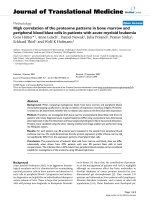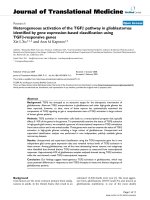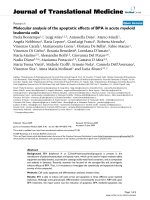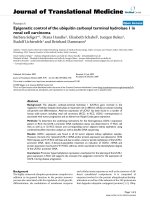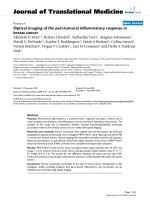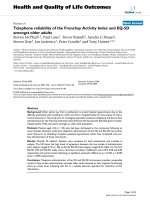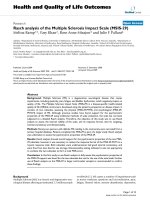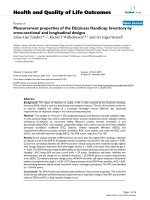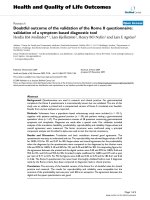Báo cáo hóa học: " Dynamic tuning of the IEEE 802.11 distributed coordination function to derive a theoretical throughput limit" pot
Bạn đang xem bản rút gọn của tài liệu. Xem và tải ngay bản đầy đủ của tài liệu tại đây (817.19 KB, 12 trang )
RESEARCH Open Access
Dynamic tuning of the IEEE 802.11 distributed
coordination function to derive a theoretical
throughput limit
Yi-Hung Huang
1*
and Chao-Yu Kuo
2
Abstract
IEEE 802.11 is the most popular and widely used standard for wireless local area network communication. It has
attracted countless numbers of studies devoted to improving the performance of the standard in many ways. In
this article, we performed theoretical analyses for providing a solution to the maximum throughput problem for
the IEEE 802.11 distributed coordination function, and an algorithm using a binary cubic equation for obtaining a
much closer approximation of the optimal solution than previous algorithms. Moreover, by studying and analyzing
the characteristics of the proposed algorithm, we found that the effects of backoff cou nter consecutive freeze
process could be neglected or even disregarded. Using the NS2 network simulator, we not only showed that the
proposed theoretical analysis complied with the simulated results, but also verified that the proposed approach
outperformed others in achieving a much closer approximation to the optimal solution.
Keywords: IEEE 802.11, distributed coordination function, performance analysis
1. Introduction
Advances in wireless communication technology have
increased the de mand for wireless networks. The I EEE
802.11 standard [1] defines the specifications for medium
access control (MAC) and the physical layers in a wire-
less local area network (WLAN). The IEEE 802.11 stan-
dard provides two mechanisms for the MAC protocol:
the point coordination function (PCF) and the distributed
coordination function (DCF). The PCF utilizes a basic
access mechanism that supports contention-free services.
Therefore, the PCF requires a base station that coordi-
nates channel access among nodes. On the other hand,
the DCF utilizes an access mechanism that supports con-
tention-based services. The DCF access mechanism dic-
tates that all the nodes should randomly access channels
using the carrier sense multiple access/collision avoid-
ance (CSMA/CA) mechanism. This mechanism employs
the acknowledgment (ACK) feature to detect transmis-
sion failures. In other words, if an ACK response is not
received,itisassumedthatpackettransmissionhas
failed. The nodes wait for an interframe space (IFS), and
then invoke the binary exponential Backoff algorithm,
which uses a uniform random distribution called a con-
tention w indow (CW) to generate a random Ba ckoff
value within the range of [0, CW - 1].
In this study, the initial value of CW is s et to CW
min
(the minimum CW). Subsequently, the CW value is
doubled when packet transmission fails. For a node to
obtain a Backoff value, it must first determine whether
the channel is in use. If the channel is not busy, then
the Backoff value decreases by 1 in every time slot and
the node transmits the data when the Backoff value
reaches zero. However, if the channel is busy, then the
Backoff counter freezes. When the channel is in an idle
state, it waits for a DCF IFS (DIFS) time period after
which the Backoff value begins to decrease again. If the
packet transmi ssion continues to fa il, then the CW
value increases to CW
max
(the maximum CW); when
the node receives an ACK packet, CW is reset to
CW
min
. If a node receives an error packet, it must wait
for an extended IFS (EIFS) time period. Then, the node
determines again whether the channel is in an idle state.
If it is, then after a DIFS time, the Backoff value
decreases by 1 after each idle slot.
* Correspondence:
1
Department of Mathematics Education, National Taichung University of
Education, Taichung 40306, Taiwan
Full list of author information is available at the end of the article
Huang and Kuo EURASIP Journal on Wireless Communications and Networking 2011, 2011:105
/>© 2011 Huang a nd Kuo; licensee Springer. This is an Open Access article distributed under the terms of the Creative Commons
Attribution Lice nse ( which permits unrestricted use, distribution, and reproduction in
any medium, provided the original work is properly cited.
Currently, the methods of improving Backoff perfor-
mance can be divided into two categories: (1) adjusting
the CW size according to the number of times that col-
lisions have occurred [1-3], and (2) dynamically adjust-
ing the CW size by detecting changes in the network
environment [4-7]. In the first type of method, the
adjustment of CW size only occurs after a collision; the
consequences are that the cost for collision must first be
paid before the method can find the most appropriate
CW size, and that this entire process is repeated when
the data are transferred successfully. In contrast, the
second type of method immedi ately adjusts to the most
appropriate CW size when network environment
changes are detected. Therefore, such a metho d has the
ability to find the appropriate CW size without the cost
of collision, and clearly outperforms the first type of
method in many ways. For the reasons mentioned
above, this article proposed an algorithm called the
dynamic contention w indow (DCW) algorithm by
adopting the second approach. Unlike other algorithms,
DCW uses a binary cubic equation that has the ability
to quickly and efficiently calculate the most appro pria te
CW size according to the network environment.
The rest of this article is organized as follows. Pre-
vious related work is presented in Section 2. Various
theoretical analyses are performed in Section 3. The
proposed DCW algorithm and consecutive freeze pro-
cess (CFP) analysis are presented in Section 4. Simula-
tions and performance evaluations of our proposed
algorithm are conducted in Section 5. Finally, we con-
clude our work in Section 6
2. Related work
To the best of our knowledge, most studies on p erfor-
mance analysis of IEEE 802.11 MAC protocols use the
results presented in [4] for their theories or discussions
[8-13].
The following equation is derived from the analytic
work in [4]:
E
Coll
× E [N
c
] =
(
E [N
c
] +1
)
× E
Idle
(1)
Here, the E[Coll] is the expected value of collision
time; E[N
c
] is the expected value of the number of
nodes that are involved in a collision; and E[Idle] is the
expected value of idle time. As long as the actual values
for E[Coll] and E[N
c
] can be measured and substituted
into (1), then the value of E[Idle] can be solved.
E[Idle] =
1 − p
M
1 −
1 − p
M
× t
slot
(2)
where M is the total number of nodes in the network,
the t
slot
the total duration spent in a time slot, and p is
the Backoff value sampled from a geometric distribution
with para meter p.First,weuse(1)tosolveE[Idle],
which we then substitute into (2) to solve p.Usingthis
value of p, we can derive the value of parameter p for
the geometric distribution from the Backoff value of
maximum throughput.
When solving (1) and (2), an optimal solution cannot
be solved directly; instead, a numerical method is
needed to approximate the optimal solution. Therefore,
the effectiveness of this method is fully dependent on
how fast the numerical method can find the approxima-
tion of the optim al soluti on.Additionally,ref.[4]
assumes that the values of E[Coll] and E[N
c
]in(1)and
(2) can be derived by measuring the network cond ition.
Unfortunately, this is not entirely true in practice. There
is no collision detection capability due to the character-
istics of the wireless networks.
Based on the solutions of (1) and (2) and by observing
the solution while solving the value of p,thevaluesofE
[N
c
]andE[Coll] mostly remain constant [4]. Therefore,
(1) can be further simplified as follows:
E[Coll] =
(
Idle, N
c
)
=
(
E [N
c
] +1
)
· E
Idle
· t
slot
E [N
c
]
(3)
where F(Idle, N
c
)isaconstant.Although(3)canbe
used to replace (1), a numerical method is still needed
for this equation to approximate the optimal solution.
The performance of this approach is fully dependent on
the efficiency of the numerical method when finding the
approximation of the optimal solution. Therefore, to
save the t ime consumed by the numerical method, we
propose a binary cubic equation with the ability to
obtain a much closer approximation of the optimal solu-
tion in less time.
3. Analysis of proposed method
In this study, we assume that (1) each node is in a satu-
rated condition (i.e., always having a pa cket to transmit)
and (2) the chann el is error-free. Packet loss is caused
solely by collisions in the process of packet transmis-
sion. The hidden termina l problem is not considered in
this article.
3.1. Analysis of collision probability
First, we divided the timeline into discrete time slots,
where the probability of transmission for each time slot
is equal to τ, in accord with [14,15]. Therefore, τ =2/E
[CW], where E[CW] is the expected value of the CW.
Suppose that there are M nodes in the network, where
τ
x
(x = 1,2, ,M) is the probability of transmission for
node x in each time slot, ACK
x
(x = 1,2, ,M)isthe
number of ACK packets successfully received by each
node, and Coll
x
(x = 1 ,2, ,M) is the number of packets
Huang and Kuo EURASIP Journal on Wireless Communications and Networking 2011, 2011:105
/>Page 2 of 12
that do not receive ACK. The collision probability can
then be defined as follows:
Collision probability = 1 −
M
x=1
ACK
x
M
x=1
(
ACK
x
+Coll
x
)
(4)
Each time slot can be classified into three states: idle
(no data transmission), successfully transmitted, and col-
lision. Therefore, the probability of each state can be
calculated as follows.
The probability of an idle time slot is calculated as (5)
and referred to as P
i
:
M
x=1
(
1 − τ
x
)
= P
i
(5)
The probability of a successfully transmitted time slot
is calculated as (6) and referred to as P
s
:
M
x=1
⎛
⎝
τ
x
M
y=1,y=x
1 − τ
y
⎞
⎠
= P
s
(6)
The probability of a collision time slot is calculated as
(7) and referred to as P
c
:
P
c
=1− P
i
− P
s
(7)
Because collision only occurs when there are at least
two nodes simultaneously transmitting data in a single
time slot. Therefore, we define k as the average number
of nodes involved in a collision, where k can be calcu-
lated as follows:
k =2×
x1=x2
⎛
⎜
⎜
⎜
⎝
τ
x1
τ
x2
M
y=1,
y=x1,
y=x2
1 − τ
y
⎞
⎟
⎟
⎟
⎠
1 − P
i
− P
s
+3×
x1=x2,
x1=x3,
x2=x3
⎛
⎜
⎜
⎜
⎜
⎜
⎜
⎜
⎜
⎜
⎜
⎜
⎜
⎜
⎜
⎜
⎜
⎝
τ
x1
τ
x2
τ
x3
M
y =1,
y = x1,
y = x2,
y = x3,
1 − τ
y
⎞
⎟
⎟
⎟
⎟
⎟
⎟
⎟
⎟
⎟
⎟
⎟
⎟
⎟
⎟
⎟
⎟
⎠
1 − P
i
− P
s
+ +
M ×
M
x=1
τ
x
1 − P
i
− P
s
(8)
Therefore, the value of Coll
x
for all the nodes involved
in a simultaneous data transmission is incremented by
1. Hence, when a collision occurs in a time slot, it is
necessary to calculate the average number of nodes
involved in the collision to facilitate calculation of the
collision probability P
c
. In addition, the collision prob-
ability in (4) can be rewritten using (5)-(8):
Collision probability = 1 −
M
x=1
ACK
x
M
x=1
(
ACK
x
+Coll
x
)
=1−
M
x=1
ACK
x
total
slot
M
x=1
(
ACK
x
+Coll
x
)
total
slot
=1−
P
s
P
s
+ P
c
× k
=1−
P
s
P
s
+
(
1 − P
s
− Pi
)
× k
(9)
By dividing the numerator and denominator, respec-
tively, by the total number of t ime slots in the network
(referred as total_slot), (4) can be represented by the
probabilities P
s
, P
i
,andP
c
. In other words, if there are
three simultaneous data transmissions, the time slots
will collide and each of the three nodes involved in this
collision will increase their Coll
x
value by 1. However,
P
c
represents the collision probability that occurs in a
time slot. Therefore, when a collision occurs in a time
slot, we calculate the v alue of k, which represents the
average number of nodes involved in simultaneous data
transmissions during that time. Therefore,
P
c
× k =
M
x=1
(
Coll
x
)
total
slot
.
When the system converges into a stable state, we
assume that τ
1
= τ
2
= τ
3
= =τ
M
= τ. Hence, we can
rewrite (5), (6), and (7) as follows.
The probability of an idle time slot is calculated as
(10) and referred to as Pi:
M
x=1
(
1 − τ
x
)
= Pi =
(
1 − τ
)
M
(10)
The probability of a successfully transmitted time slot
is calculated as (11) and referred to as P
s
:
M
x=1
⎛
⎝
τ
x
M
y=1,y=x
1 − τ
y
⎞
⎠
= P
s
= M × τ ×
(
1 − τ
)
M−1
(11)
The average number of nodes involved in simulta-
neous data transmission during a collision is given as
follows:
k =
M
i=2
i ×
M
i
τ
i
×
(
1 − τ
)
M−i
1 − P
i
− P
s
=
M
i=2
i ×
M
i
τ
i
×
(
1 − τ
)
M−i
+ M × τ ×
(
1 − τ
)
M−1
− M × τ ×
(
1 − τ
)
M−1
1 − P
i
− P
s
.
=
M
i=1
i ×
M
i
τ
i
×
(
1 − τ
)
M−i
− M × τ ×
(
1 − τ
)
M−1
1 − P
i
− P
s
=
M × τ − M × τ ×
(
1 − τ
)
M−1
1 − P
i
− P
s
(12)
M
i=1
i ×
M
i
τ
i
×
(
1 − τ
)
M−i
is the expected value of
the binomial distribution. Therefore, it is equal to M ×
τ. We then substitute (10), (11), and (12) into (9) and
derive the collision probability as follows:
Collision probability = 1 − P
s
P
s
+
(
1 − P
i
− P
s
)
× k
=1−
M × τ ×
(
1 − τ
)
M−1
M × τ ×
(
1 − τ
)
M−1
+
(
1 − Pi − Ps
)
×
M × τ − M × p ×
(
1 − τ
)
M−1
1 − P
i
− P
s
=1−
(
1 − τ
)
M−1
(13)
In (13), the collision probability can be calculated
using the total number of nodes, M, and the probability
Huang and Kuo EURASIP Journal on Wireless Communications and Networking 2011, 2011:105
/>Page 3 of 12
of transmission, τ, during a time slot under conditions of
a fully utilized throughput environment. The result of
(13) also shows t hat it is easy to calculate and analyze
the collision probability.
3.2. Analysis of maximum throughput
According to [14], throughput is defined as follows:
throughput =
P
s
× pa yload
P
i
× t
slot
+ P
s
× t
success
+ P
c
× t
coll
(14)
where payload is the time spent to transmit data, t
slot
is an idle slot time (aSlotTime), and t
success
is the time
spent to transmit a packet successfully. Notably, t
success
=DATA+SIFS+ACK+DIFSwhenthealgorithm
does not utilize the RTS/CTS method. Furthermore,
t
coll
is the time spent during packet collision, and t
coll
=DATA
max
+ DIFS when the algorithm does not uti-
lize the RTS/CTS method. DATA
max
is the maximum
waiting time when a packet collision occurs. Most
other studies have assumed that DATA
max
is equal to
DATA. However, according to the IEEE 802.11 stan-
dard presented in [1], nodes involved in a collision
must wait for one more EIFS in addition to DATA.
Hence, this article assumes that DATA
max
=DATA+
EIFS × (M - k)/M,whereM is the total number of
nodes in the network and k is the average number of
nodes involved in simultaneous d ata transmissions.
This assumption makes it clear that there are k nodes
on an average that are busy transmitting data, and that
the transmission nodes are unable t o receive any other
packets from other nodes. Therefore, because the
transmission nodes need not w ait for another EIFS, the
number of transmission nodes must be deducted from
the equation.
By substituting (7), (10), and (11) into (14) and simpli-
fying, we get the following:
throughput =
M × τ × payload
t
coll
(
1 − τ
)
M−1
+
(
1 − τ
)
×
(
t
slot
− t
coll
)
+ M × τ ×
(
t
success
− t
coll
)
(15)
To solve the maximum throughput, we differentiate τ
in (15) (as shown in Appendix A). To reduce the com-
plexity of solving the maximum throughput, we assume
that t
coll
is a constant. This gives us the equation below:
1 − M × τ
(
1 − τ
)
M
=1−
t
slot
t
coll
(16)
The right-hand side of (16) assumes a value between 0
and 1 because t
coll
>t
slot
. The left-hand side of (16) is
equal to 1 when τ = 0; however, it is 0 if τ =1/M. When
0<τ <1/M, the left-hand side becomes a decreasing
function that varies between 1 and 0. Therefore, the
optimal solution for τ can be obtained.
The Abel-Ruffini theorem (also known as Abel’ s
impossibility theorem) [16] states that there is no gen-
eral algebraic solution to polynomial equations of the
fifth degree or higher. For this reason, an algebraic solu-
tion is impossible with (16) when M is greater than 5.
Therefore, with the network parameters provided in
Table 1 we adopt a numerical method to solve (16)
while all nodes in the network are transmitting constant
length data packets, and observe the relation between
the CW (2/τ) and M.
In Figure 1, the x-axisrepresentsthenumberof
nodes, the y-axis represents the CW (2/τ), and the num-
bers 500, 1500, and 2312 represent constant packet sizes
in bytes. Figure 1 clearly shows that the relation ship
between the CW (2/τ) and M is linear (other packet size
have the same linear relationship). Therefore, we con-
ducted regression analyses to solve the relationship
between the CW (2/τ)andM, the results of which are
shown in Table 2. (The results of different packet sizes
are illustrated in Appendix C.)
In Table 2 th e value of R
2
is almost equal to 1. This
verifies that the result of the regression analysis is
almost consistent with the solution of (16).
The results of Appendix C indicate that different packet
sizes lead to different results for regression analysis. Figure
2 shows the relationship of the packet size to the first-
degree coefficient and the constant in Appendix C.
In Figure 2, the x-axisrepresentsthelengthofthe
packet, and the y-axis represen ts the f irst-degree c oeffi-
cient and the constant. The curves for the coefficient of M
and constant represent the first-degree coe fficients and
the constant, respectively. The results of F igure 2 clearly
show that the packet length is linearly related to both the
first-degree coefficient and the constant term. Therefore,
by applying quadratic regression analysis to Figure 2, we
obtained the coefficients of determination for the coeffi-
cients of M and the constant term in Table 3.
As shown in the table, the R
2
values are both greater
than 0.975. This implies that the quadratic fit to the
results in Figure 2 is good. In order to obtain the CW
size of maximum throughput, we must first substitute
Table 1 WLAN parameters
DataRate 11 Mbps
PCLPDataRate 1 Mbps
BasicRate 1 Mbps
Slot time 20 μs
SIFS 10 μs
DIFS 50 μs
EIFS SIFS + DIFS + (ACK length)/basic rate
PHYHeader 192 bits
MACHeader 224 bits
ACK length 112 bits + PHYHeader
Huang and Kuo EURASIP Journal on Wireless Communications and Networking 2011, 2011:105
/>Page 4 of 12
the packet length into Table 3 to solve the number of
nodes and the coefficients of the linear equation of the
CW, and then substit ute the number of nodes into the
target linear equation. We thereby obtain the CW size
of maximum throughput. Therefore, in the next section,
we propose the DCW algorithm.
4. DCW algorithm
In order to achieve maximum throughput with the ana-
lyses from Appendix C and Table 3 with the network
environment parameters presented in Table 1 we com-
bined the equations from Appendix C and Table 3 into
(17). Here, the size of the CW is strongly related to the
number of nodes (M) and the packet length (X).
CW =
−3.71095 × 10
−7
X
2
+3.9512× 10
−3
X + 8.6886
M
+1.32129 × 10
−7
X
2
+4.1818× 10
−4
X + 7.8933
(17)
In (17), we only need to substitute the packet length
into X and the number of nodes into M to obtain the
CW size of maximum throughput.
The proposed DCW algorithm (DCW) is shown in
Figure 3.
When transmitting data using DCW, it is called
upon to obtain the Backoff value regardless of the suc-
cess or failure (data retransmission required) of data
transmission. After each aSlotTime, the Backoff Time
reduces an aSlotTime, and if the medium is busy dur-
inganaSlotTime,thereductionofanaSlotTimefrom
Backoff Time is stopped until the medium is once
again idle. When the medium become s idle, it must
wait for a DIFS time before continuing the countdown
of the B ackoff Time. The countdown goes on until the
Backoff Time reaches 0, after which data transmission
begins.
There have already been many methods proposed by
other authors to estimate the number of nodes in the
network [17,18], by applying t hese methods in the pro-
posed DCW. DCW is then suitable for network environ-
ments in which the number of nodes changes
dynamically.
4.1. Backoff counter CFP
In IEEE 802.11, when a node completes its data trans-
mission, it obtains another Backoff value via t he Backoff
procedure before it starts another round of data trans-
mission. If the Backoff value obtained from the Backoff
procedure is 0, it indi cates that the node that has a
Backoff value of 0 may transmit data packets immedi-
ately without reducing its value, while it also indicates
that other nodes may not reduce their Backoff values.
However, a transiting node that consecutively obtains a
Backoff value of 0 will result in all other nodes to freeze
their reduction in the Backoff procedure. This type of
phenomenon is referred to as a Backoff Counter CFP
[15,19].
The occurrence probability of CFP is determined by
the number of nodes and the CW size. There are two
conditions in CFP. First, if a node successful ly transmits
its data packets, the CFP occurrence probability is 1/
Figure 1 CW as a function of the number of nodes.
Table 2 Regression analysis
Packet size
(bytes)
Regression analysis
(2/τ)
Coefficient of
determination (R
2
)
500 10.6M-8.0068 1
1500 13.762M-8.9413 1
2312 15.847M-9.3857 1
Huang and Kuo EURASIP Journal on Wireless Communications and Networking 2011, 2011:105
/>Page 5 of 12
CW because only one node may obtain a Backoff value
of 0 (condition (1)). Second, if multiple nodes transmit
data packets simultaneously, the average CFP occur-
rence probability is 1 - (1 - 1/CW)
k
(when a collision
occurs, k is the average number of nodes that partici-
pates in the collision) (condition (2)). This is because
there are k no des on average trying to transmit data
packets simultaneously, and hence k nodes on average
may obtain a Backoff value of 0.
The DCW did not take the phenomenon of CFP
into consideration during the analysis process. This is
because the occurrence probability of CFP is very low
in DCW; in particular, when the number of nodes
increases, the occurrence probability of CFP declines.
In DCW, CW = C1 *M+C2, where M is the num-
ber of nodes, C1andC2 are constants (8.5 <C1<
16.3; -9.8 <C2 < -7.9), and the range of packet
lengths is 1-2312 bytes. Therefore, when the n umber
of nodes increases, the CW also increases in concert.
Yet the occurrence probability of CFP in condition
(1) decreases when the number of nodes inc reases.
As for the occurrence probability of CFP in condition
(2), the k nodes on average that participate in a colli-
sion must be used for the analysis. Thus, we set the
value of M in (9) to be a value that approaches infi-
nity, and then check whether k a pproaches a constant
value.
lim
M→∞
M × τ − M × τ ×
(
1 − τ
)
M−1
1 − P
i
− P
s
=
2
C
1
−
2
C
1
e
1
−C
1
1 − e
2
−C
1
−
2
C
1
e
2
−C
1
(18)
In (18), e denotes a natu ral number. The detailed
proof is available in Appendix B. From (18), the value of
k approaches a constant value as the number of nodes
increases.
Figure 4 uses the network environment parameters
presented in Table 1; x-axisrepresentsthenumberof
nodes, y-axis represents the k value, and the numbers
500, 1500, and 2312 represent packet sizes in bytes. The
results of different packet lengths are presented in
Appendix C.
From the results obtained from Appendix C and Fig-
ure 4, the range for k is 2-2.081. This is because shorter
thedatapacketlength,thelargerthevalueofk.How-
ever, it is impossible to have a data packet less than 1
byte. Therefore, the maximum value of k is the same as
the data packe t length of 1 byte. Therefore, the occur-
rence probability of CFP in condition (2) is less than 1 -
(1 - 1/CW)
2.81
, although CW increases as the number of
Figure 2 Coefficient of M and constant as a function of packet length.
Table 3 Coefficient of M and constant
Regression analysis (X: packet length) Coefficient of determination (R
2
)
Coefficient of M -3.71095 × 10
-7
X
2
+ 3.9512 × 10
-3
X + 8.6886 0.9998
Constant 1.32129 × 10
-7
X
2
+ 4.1818 × 10
-4
X + 7.8933 0.9751
Huang and Kuo EURASIP Journal on Wireless Communications and Networking 2011, 2011:105
/>Page 6 of 12
nodes increases where the occurrence probability of CFP
in condition (2) becomes increasingly smaller.
From the above analysis on the occurrence probability
of CFP, the occurrence probability of CFP is very low
when using the DCW method. This also implies that in
situations where the number of nodes propagates, the
impact of CFP may be neglected.
5. Simulations
5.1. Environmental settings
In this article, we use NS2 [20] as the simulation tool
and use the network environment parameters presented
in Table 1 as simulation parameters. Each simulation
runs for 100 simulated seconds. The simulation uses the
normalized throughput indicated in (14) and the
backofftime()
// M: number of nodes
// X: packet length
// C1: the coefficient of M
// C2: the coefficient of constant
// CW: contention window
// aSlotTime: the value of the correspondingly named PHY characteristic
C1 = -3.71095 10
-7
X
2
+ 3.9512 10
-3
X + 8.6886
C2 = 1.32129 10
-7
X
2
+ 4.1818 10
-4
X + 7.8933
CW = C1 M + C2
// {0, 1, 2, …, CW -1} Randomly selected integer value
backoff_value = Uniform (CW)
return backoff_value×aSlotTime
Figure 3 DCW algorithm.
Figure 4 Dependence of k on the number of nodes.
Huang and Kuo EURASIP Journal on Wireless Communications and Networking 2011, 2011:105
/>Page 7 of 12
collision probability indicated in (4) as performance
indicators.
5.2. Different data packet lengths
We are currently using DCW and different data packet
lengths to verify the analyses of (9) and (14).
In Figure 5, the x-axisrepresentsthenumberof
nodes, y-axis represents the collision probability, and
the numbers 500, 1500, and 2312 are the numerical
results for the corresponding packet sizes in bytes sub-
sti tuted into (9), and 500, 1500, and 2312 are the simu-
lation results for the corresponding packet sizes in
bytes. The different data packet lengths show similar
results, as shown in Figure 5. CW is an integer, and it is
essential t o round 2/τ off to an integer. For this reason,
the analysis results show non-smooth characteristics.
The results of Figure 5 show that the simulated and
analytical results are very close.
Using the t distribution and under 99% confidence
level, the experiments sampling e rror for 500, 1500 and
2312 bytes is within ± 0.141%, ± 0.193%, and ± 0.302%,
respectively.
In Figure 6, the x-axisrepresentsthenumberof
nodes, y-axis represents the normalized throughput, and
the numbers 500, 1500, and 2312 are the numerical
results for the corresponding packet sizes in bytes sub-
stituted into (14), and 500, 1500, and 2312 are the simu-
lated results using the corresponding packet sizes in
bytes. The different data packet lengths show similar
results, as shown in Figure 6. CW is an integer, and it is
essential t o round 2/τ off to an integer. For this reason,
the analysis results also show non-smooth characteris-
tics. The results of Figure 6 show that the simulated and
analytical results are very close.
Using the t distribution and under 99% confidence level,
the e xperiments s ampling error for 50 0, 1500, and 2312 bytes
is within ± 0.65 6%, ± 0.559%, and ± 0.733%, respectively.
5.3. Comparison between different algorithms
We compare DCW with other algorithms to verify that
the DCW is able to provide a relatively close approxi-
mation to the maximum throughput. In order to show
the differences in IEEE 802.11
+
[4] and DCW, the scale
for the y-axis in Figure 7a, c, e (DCF versus DCW) as
well as Figure 7b, d, f (IEEE 802.11
+
versus DCW) is dif-
ferent. IEEE 802.11
+
is very close to the maximum
throughput ; however, by narro wing the distance
between the y-axis scale spans, we can clearly see that
the DCW provides an even closer appro ximation to the
maximum throughput than IEEE 802.11
+
.
In Figure 7, the x- and y-axes represent the number of
nodes and the collision probability, respectively. The
DCF curve uses the standard IEEE 802.11 algorithm,
and the curve for IEEE 802.11
+
uses the algorithm pre-
sented in [4] where the number of nodes is known.
Similar results are obtained for different packet lengths,
asshowninFigure7.Fromthese results, the collision
probability is lower in DCW than in the other two algo-
rithms. The DCF shows lower collision probability only
when the number of nodes is between 2 and 4.
Using the t distribution and under 99% confidence
level, the DCF experiments sampling error for 500,
1500, and 2312 bytes is within ± 0.134%, ± 0.265%, and
± 0.444%, respectively, and the IEEE 802.11
+
experi-
ments sampling error for 500, 1500, and 2312 bytes is
within ± 0.154%, ± 0.248%, and ± 0.291%, respectively.
In Figure 8, the x-andy -axes represent the number of
nodes and the normalized throughput, respectively. The
Figure 5 Collision probability.
Huang and Kuo EURASIP Journal on Wireless Communications and Networking 2011, 2011:105
/>Page 8 of 12
Figure 6 Normalized throughput.
(a) 500 Bytes: DCF vs. DCW (b) 500 Bytes: IEEE 802.11
+
vs. DC
W
(c) 1500 Bytes: DCF vs. DCW (d) 1500 Bytes: IEEE 802.11
+
vs. DC
W
(
e
)
2312 B
y
tes: DCF vs. DCW
(
f
)
2312 B
y
tes: IEEE 802.11
+
vs. DC
W
Figure 7 Collision probability. (a) 500 bytes: DCF versus DCW. (b) 500 bytes: IEEE 802.11
+
versus DCW. (c) 1500 bytes: DCF versus DCW. (d)
1500 bytes: IEEE 802.11
+
versus DCW. (e) 2312 bytes: DCF versus DCW. (f) 2312 bytes: IEEE 802.11
+
versus DCW.
Huang and Kuo EURASIP Journal on Wireless Communications and Networking 2011, 2011:105
/>Page 9 of 12
DCF curve uses the standard IEEE 802.11 alg orithm, and
the curve for I EEE 802.11
+
uses the algorithm presented
in [4] where the number of nodes is known. Similar results
are obtained for the different packet leng ths, as shown in
Figure 8. From these results, the normalized throughput is
higher in DCW than in the other two algorithms.
Although IEEE 802 .11
+
and DCW show simila r results
when the packet lengths are 1500 and 2312 bytes, DCW
still shows relatively high normalized throughput.
Using the t distribution and under 99% confidence
level, the DCF experiments sampling error for 500,
1500, and 2312 bytes is within ± 0.413%, ± 0.556%, and
± 0.768%, respectively, and the IEEE 802.11
+
experi-
ments sampling error for 500, 1500, and 2312 bytes is
within ± 0.664%, ± 0.669%, and ± 0.678%, respectively.
6. Conclusions
In this article, we take the influence of EIFS into consid-
eration whereas previous literatures did not. In doing so,
we are able to provide analysis results that are much
closer to simulated results. An observation of the results
clearly indicates that the influence of EIFS should not
be ignored. Moreover, this article also proposes an algo-
rithm that is distinct from others that only use numeri-
cal methods. This algorithm is able to find the CW size
of maximum throughput immediately by substituting
the packet length and number of nodes into a binary
cubic equation. From the mathematical analyses pro-
vided in this article, it is shown that the influence of
CFP is extremely small or even negligible using pro-
posed algorithm.
For studies in the near future, other parameters of
network environments can be considered for multidi-
mensional experiments. For example, different values for
DataRate can be used for a more realistic wireless net-
work environment.
Appendix A
The inference process of maximum throughput is differ-
entiated by τ in (15).
(a) 500 Bytes: DCF vs. DCW (b) 500 Bytes: IEEE 802.11
+
vs. DC
W
(c) 1500 Bytes: DCF vs. DCW (d) 1500 Bytes: IEEE 802.11
+
vs. DC
W
(
e
)
2312 B
y
tes: DCF vs. DCW
(
f
)
2312 B
y
tes: IEEE 802.11
+
vs. DC
W
Figure 8 Normalized throughput. (a) 500 bytes: DCF versus DCW. (b) 500 bytes: IEEE 802.11
+
versus DCW. (c) 1500 bytes: DCF versus DCW. (d)
1500 bytes: IEEE 802.11
+
versus DCW. (e) 2312 bytes: DCF versus DCW. (f) 2312 bytes: IEEE 802.11
+
versus DCW.
Huang and Kuo EURASIP Journal on Wireless Communications and Networking 2011, 2011:105
/>Page 10 of 12
∴ When
t
Coll
(
1 − τ
)
M−1
+
(
t
slot
− t
Coll
)
− τ ×
(
M − 1
)
×
t
Coll
(
1 − τ
)
M
=0
, the through-
put assumes an extreme value
∴
t
Coll
(
1 − τ
)
M
((
1 − τ
)
− τ ×
(
M − 1
))
= t
Coll
− t
slot
⇒
t
Coll
(
1 − τ
)
M
(
1 − τ × M
)
= t
Coll
− t
slot
⇒
(
1 − τ × M
)
(
1 − τ
)
M
=1−
t
slot
t
Coll
is proven.
Appendix B
When collision occurs, the average number of nodes
that participate in a collision is k.Whenthenumberof
nodes approaches infinity and DCW is used, k
approaches a constant value. From the results of (17),
when the packet length is fixed,
CW = C
1
× M + C
2
,
(B1)
where CW is the contention window, C
1
and C
2
are
constants, and M is the number of nodes. Thus, the
probability of transmission τ is
τ =2/E[CW] = 2/CW = 2/(C1 × M+C2)
(B2)
When the number of nodes M approaches infinity,
lim
M→∞
(
1 − τ
)
M
= lim
M→∞
1 −
2
C
1
× M + C
2
M
= lim
M→∞
1 −
2
C
1
× M + C
2
⎛
⎝
−C
1
× M − C
2
2
⎞
⎠
⎛
⎜
⎜
⎜
⎜
⎝
2
−C
1
−
C
2
M
⎞
⎟
⎟
⎟
⎟
⎠
= e
lim
M→∞
⎛
⎜
⎜
⎜
⎜
⎝
2
−C
1
−
C
2
M
⎞
⎟
⎟
⎟
⎟
⎠
=
e
−2
C
1
(B3)
From (10), P
i
= (1-τ)
M
, when M approaches infinity, P
i
approaches
e
−2
C
1
.
lim
M→∞
M × τ ×
(
1 − τ
)
M−1
= lim
M→∞
M ×
2
C
1
× M + C
2
×
1 −
2
C
1
× M + C
2
M−1
= lim
M→∞
2
C
1
+
C
2
M
× lim
M→∞
1 −
2
C
1
× M + C
2
⎛
⎝
−C
1
× M − C
2
2
⎞
⎠
⎛
⎜
⎜
⎜
⎜
⎝
2 −
2
M
−C
1
−
1
C
2
⎞
⎟
⎟
⎟
⎟
⎠
=
2
C
1
× e
lim
M→∞
⎛
⎜
⎜
⎜
⎜
⎝
2 −
2
M
−C
1
−
C
2
M
⎞
⎟
⎟
⎟
⎟
⎠
=
2
C
1
e
−2
C
1
(B4)
From (11), P
s
= M × τ × (1-τ)
M-1
, when M approaches
infinity, P
s
approaches
2
C
1
e
−2
C
1
.From(12),
k =
M × τ − M × τ ×
(
1 − τ
)
M−1
1 − P
i
− P
s
,whenM approaches
infinity, we obtain the following using (B2), (B3), and
(B4):
lim
M→∞
M × τ − M × τ ×
(
1 − τ
)
M−1
1 − P
i
− P
s
= lim
M→∞
M ×
2
M × C
1
+ C
2
− P
s
1 − P
i
− P
s
= lim
M→∞
2
C
1
+ C
2
M
− P
s
1 − P
i
− P
s
=
2
C
1
−
2
C
1
e
1
−C
1
1 − e
2
−C
1
−
2
C
1
e
2
−C
1
(B5)
From the results of (B5), when the number of nodes
approaches infinity and DCW is used, k approaches a
constant value.
Appendix C
Equation 16 uses the network parameters provided in
Table 1 and packet size in the range of 1-2312 bytes.
When solving the relationship between contention win-
dow (2/τ)andM, we obtain the results presented in
table 4 using regression analysis, where
lim
M→∞
k
is
obtained by (B5):
Acknowledgements
This study was supported in part by the National Science Council, Taiwan,
under Grant NSC99-2221-E-142-007.
Table 4 Regression analysis results and limits of k
Packet size (100-500 bytes) Regression analysis (2/τ) Coefficient of determination (R
2
)
lim
M→∞
k
1 8.5684M-8.1523 1 2.080878232
100 9.0133M-8.2238 1 2.076739841
500 10.6M-8.0068 1 2.06489532
1000 12.289M-8.4472 1 2.055736278
1500 13.762M-8.9413 1 2.049627138
2000 15.084M-9.2797 1 2.045182161
2312 15.847M-9.3857 1 2.042961214
Huang and Kuo EURASIP Journal on Wireless Communications and Networking 2011, 2011:105
/>Page 11 of 12
Author details
1
Department of Mathematics Education, National Taichung University of
Education, Taichung 40306, Taiwan
2
Department of Computer Science and
Engineering, National Chung Hsing University, Taichung 402, Taiwan
Competing interests
The authors declare that they have no competing interests.
Received: 15 April 2011 Accepted: 20 September 2011
Published: 20 September 2011
References
1. IEEE Computer Society, IEEE standard 802.11, wireless LAN medium access
control (MAC) and physical layer (PHY) specifications (New York, 1999)
2. H Minooei, H Nojumi, Performance evaluation of a new backoff method for
IEEE 802.11. Comput Commun. 30(18), 3698–3704 (2007). doi:10.1016/j.
comcom.2007.07.003
3. L Yun, L Ke-Ping, Z Wel-Liang, C Qian-Bin, A novel random backoff
algorithm to enhance the performance of IEEE 802.11 DCF. Wirel Personal
Commun. 36(1), 29–44 (2006). doi:10.1007/s11277-006-6176-8
4. F Cali, M Conti, E Gregori, Dynamic tuning of the IEEE 802.11 protocol to
achieve a theoretical throughput limit. IEEE/ACM Trans Netw. 8(6), 785–799
(2000). doi:10.1109/90.893874
5. R Bruno, M Conti, E Gregori, A simple protocol for the dynamic tuning of
the backoff mechanism in IEEE 802.11 networks. Comput Netw. 37(1),
33–44 (2001). doi:10.1016/S1389-1286(01)00197-9
6. Y Chetoui, N Bouabdallah, Adjustment mechanism for the IEEE 802.11
contention window: an efficient bandwidth sharing scheme. Comput
Commun. 30(13), 2686–2695 (2007). doi:10.1016/j.comcom.2007.06.006
7. B-J Kwak, N-O Song, LE Miller, Performance analysis of exponential backoff.
IEEE/ACM Trans Netw. 13(2), 343–355 (2005)
8. L Bononi, M Conti, E Gregori, Runtime optimization of IEEE 802.11 wireless
LANs performance. IEEE Trans Parallel Distrib Syst. 14(12), 1–15 (2003)
9. R Bruno, M Conti, E Gregori, Optimization of efficiency and energy
consumption in p-persistent CSMA-based wireless LANs. IEEE Trans Mobile
Comput. 1(1), 10–31 (2002). doi:10.1109/TMC.2002.1011056
10. F Cali, M Conti, E Gregori, IEEE 802.11 protocol: design and performance
evaluation of an adaptive backoff mechanism. IEEE J Sel Areas Commun.
18(9), 1774–1786 (2000). doi:10.1109/49.872963
11. Y Kwon, Y Fang, H Latchman, A novel MAC protocol with fast collision
resolution for wireless LANs, in Proceedings of the IEEE INFOCOM’03, 2,
853–862 (2003)
12. T-H Lee, A Marshall, B Zhou, An optimization scheme for energy efficient
ad-hoc wireless networks operating in error-prone channel conditions, in
Proceedings of the World Congress on Engineering 2009, vol. 1. (London, UK,
2009). WCE 2009, July 1-3
13. AHM Rad, J Huang, M Chiang, VWS Wong, Utility-optimal random access
without message passing. IEEE Trans Wirel Commun. 8(3), 1073–1079 (2009)
14. G Bianchi, Performance analysis of the IEEE 802.11 distributed coordination
function. IEEE J Sel Areas Commun. 18(3), 535–547 (2000). doi:10.1109/
49.840210
15. G Bianchi, I Tinnirello, Remarks on IEEE 802.11 DCF performance analysis.
IEEE Commun Lett. 9(8), 765–767 (2005). doi:10.1109/LCOMM.2005.1496609
16. RG Ayoub, Paolo Ruffini’s contributions to the quintic. Arch History Exact
Sci. 23(3), 253–
277 (1980). doi:10.1007/BF00357046
17. AL Toledo, T Vercauteren, X Wang, Adaptive optimization of IEEE 802.11
DCF based on Bayesian estimation of the number of competing terminals.
IEEE Trans Mobile Comput. 5(9), 1283–1296 (2006)
18. G Bianchi, I Tinnirello, Kalman filter estimation of the number of competing
terminals in an IEEE 802.11 network. in Proc Infocom 2003, 2, 844–852,
(March 2003)
19. CH Foh, JW Tantra, Comments on IEEE 802.11 saturation throughput
analysis with freezing of backoff counters. IEEE Commun Lett. 9(2), 130–132
(2005). doi:10.1109/LCOMM.2005.02008
20. Network Simulator />doi:10.1186/1687-1499-2011-105
Cite this article as: Huang and Kuo: Dynamic tuning of the IEEE 802.11
distributed coordination function to derive a theoretical throughput
limit. EURASIP Journal on Wireless Communications and Networking 2011
2011:105.
Submit your manuscript to a
journal and benefi t from:
7 Convenient online submission
7 Rigorous peer review
7 Immediate publication on acceptance
7 Open access: articles freely available online
7 High visibility within the fi eld
7 Retaining the copyright to your article
Submit your next manuscript at 7 springeropen.com
Huang and Kuo EURASIP Journal on Wireless Communications and Networking 2011, 2011:105
/>Page 12 of 12
